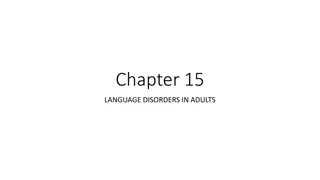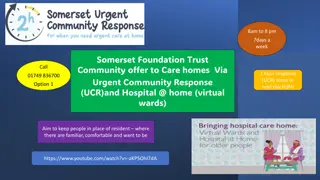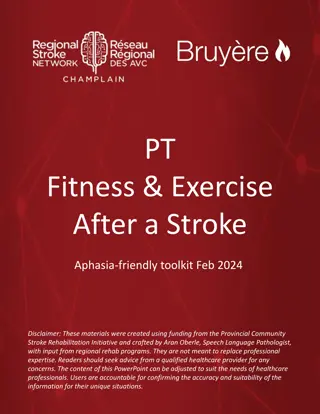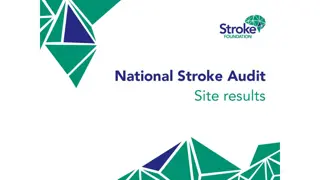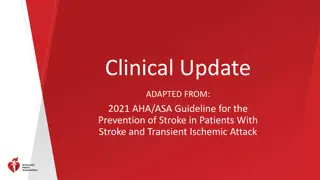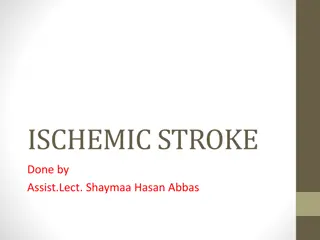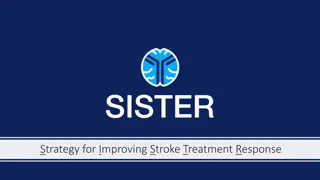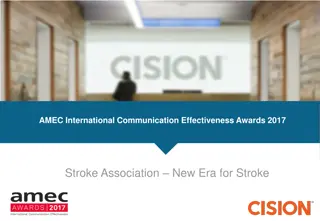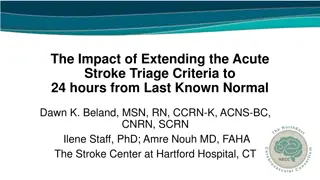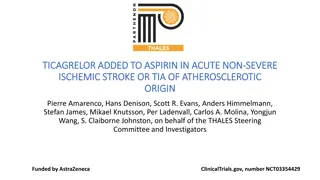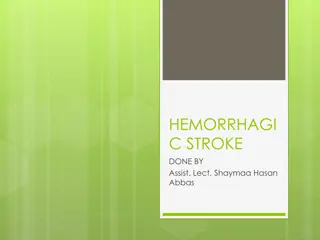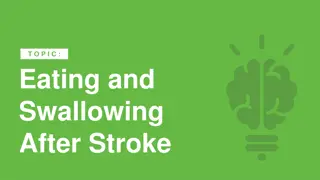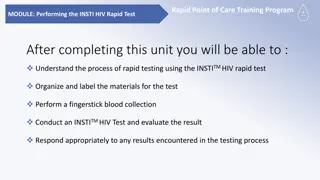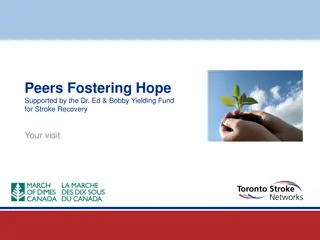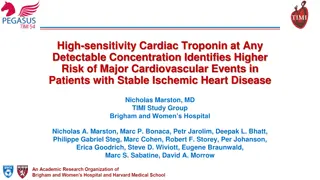Rapid Response to Ischemic Stroke: Assessment and Management
Learn about acute ischemic stroke diagnosis and initial prehospital and ED evaluation. Understand the importance of prompt action to improve patient outcomes. Images and guidelines provided.
Download Presentation

Please find below an Image/Link to download the presentation.
The content on the website is provided AS IS for your information and personal use only. It may not be sold, licensed, or shared on other websites without obtaining consent from the author.If you encounter any issues during the download, it is possible that the publisher has removed the file from their server.
You are allowed to download the files provided on this website for personal or commercial use, subject to the condition that they are used lawfully. All files are the property of their respective owners.
The content on the website is provided AS IS for your information and personal use only. It may not be sold, licensed, or shared on other websites without obtaining consent from the author.
E N D
Presentation Transcript
ENLS Version 5.0 Acute Ischemic Stroke Content: Archana Hinduja, MD; M Sohel Ahmed, MD Slides: Archana Hinduja, MD; M Sohel Ahmed, MD
Editors Note: Global Considerations The intent of the editors, authors, and reviewers of this ENLS topic was not to address all the variations in international practice for the different diseases. We have discussed major practice variances (e.g., the availability of diagnostic testing, or the type of medications used) and encourage learners to use the ENLS algorithms as a framework on which any relevant local practice guidelines can be incorporated.
Stroke Clinical diagnosis Sudden onset of neurological deficit that can be explained by vascular cause Unable to distinguish between a hemorrhagic and ischemic stroke until imaging obtained
Initial Prehospital Evaluation by EMS: History & physical Determine LKW ABCs Glucose check Stroke screen exam Obtain IV access Obtain blood vials for eval at ED Call and transport to closest certified Stroke Center Activate prehospital notification Consider taking patient directly to imaging on EMS gurney (brief doorway assessment)
ED Evaluation Checklist for the first hour Activate stroke code system (if available) Vital signs Maintain oxygen saturation >94% Determine time of onset / LKW Determine NIHSS score CT, CTA Medication list (e.g. anticoagulants) IV access 18g peripheral IV Labs: capillary glucose, CBC with platelets, PT/INR, PTT, and beta-HCG EKG
ABCD2Criteria Points 1 1 Age 60 years BP 140/90 mmHg at initial evaluation Clinical features of the TIA: Speech disturbance without weakness, or Unilateral weakness Duration of symptoms: 10-59 minutes, or 60 minutes Diabetes mellitus in patient s history 1 2 1 2 1
Transient Ischemic Attack Start antithrombotic agent ASA, clopidogrel, ASA/dipyridamole Start high-intensity statin (consider moderate intensity in age >75 yrs) Carotid imaging (ultrasound, CTA, MRA) Consider transthoracic echocardiogram Consider 30-day ambulatory cardiac monitor Encourage smoking cessation
Test Question #1 A 62-year-old man presents to the hospital after a TIA. He has a history of hypertension and tobacco use but is not taking any medications. He is at neurological baseline; head CT was unremarkable; the ABCD2 score is 2; there is no evidence of atrial fibrillation. What would constitute an appropriate management plan? A. Obtain a STAT MRI and administer tPA if there is demonstrable injury. B. Discharge home on antiplatelet therapy and a statin with follow-up in 90 days. C. Admit to the ICU for q1h neuro checks and administer tPA if symptoms return. D. Discharge home on antiplatelet therapy and a statin with outpatient follow- up in 1-2 days.
Test Question #1 A 62-year-old man presents to the hospital after a TIA. He has a history of hypertension and tobacco use but is not taking any medications. He is at neurological baseline; head CT was unremarkable; the ABCD2 score is 2; there is no evidence of atrial fibrillation. What would constitute an appropriate management plan? A. Obtain a STAT MRI and administer tPA if there is demonstrable injury. B. Discharge home on antiplatelet therapy and a statin with follow-up in 90 days. C. Admit to the ICU for q1h neuro checks and administer tPA if symptoms return. D. Discharge home on antiplatelet therapy and a statin with outpatient follow- up in 1-2 days.
Test Question #2 A 79-year-old female goes to bed at 10 p.m., awakens at 6 a.m., and notices her left arm is floppy and her left face droops. The patient's daughter calls her mom at 6:30 a.m. and notices slurring speech. When the daughter arrives at her mother's house at 7 a.m., she notices that her mom looks only to the right side. The daughter calls 911 at 7:15 a.m., and the patient arrives in the ED at 7:45 a.m. Based on her case presentation, what is the time used to determine eligibility for possible tPA treatment? A. 6 a.m. B. 6:30 a.m. C. 7 a.m. D. 7:45 a.m. E. 10 p.m. the night prior
Test Question #2 A 79-year-old female goes to bed at 10 p.m., awakens at 6 a.m., and notices her left arm is floppy and her left face droops. The patient's daughter calls her mom at 6:30 a.m. and notices slurring speech. When the daughter arrives at her mother's house at 7 a.m., she notices that her mom looks only to the right side. The daughter calls 911 at 7:15 a.m., and the patient arrives in the ED at 7:45 a.m. Based on her case presentation, what is the time used to determine eligibility for possible tPA treatment? A. 6 a.m. B. 6:30 a.m. C. 7 a.m. D. 7:45 a.m. E. 10 p.m. the night prior
Case 65-year-old woman presents to ED with: Left face and arm weakness Inattention and visual field deficit Onset 30 mins prior (witnessed) PMH: hypertension and hyperlipidemia Meds: simvastatin, lisinopril and baby aspirin Vitals: afebrile; BP 160/90 mmHg; P 95/min; RR 18/min; O2sat 98% NIHSS 14 General exam unremarkable Bedside blood sugar check normal
Case: Imaging Volume of ischemic core = 25 mL Volume of perfusion lesion = 96 mL Mismatch volume = 71 mL Mismatch ratio = 3.8
Absolute Contraindications for IV tPA - Abbreviated Major head trauma, ischemic stroke, intracranial/spinal surgery in previous 3 months History of intracerebral hemorrhage or intracranial neoplasm Signs and symptoms of subarachnoid hemorrhage, infective endocarditis, or aortic arch dissection GI malignancy or recent bleeding within 21 days Taking direct thrombin inhibitors or direct factor Xa inhibitors or warfarin (INR > 1.7) CT shows severe hypoattenuation, hypodensity > 1/3 of cerebral hemisphere or intracerebral hemorrhage
Case < 3 hours from onset NIHSS 14 Bedside blood sugar check normal Head CT without hemorrhage No contraindications BP < 185/110 mmHg
IV tPA Delivery Two peripheral IV lines Calculate actual body weight Can be estimated by two experienced providers 0.9 mg/kg (MAX 90 mg) 10% given in bolus over 1stminute The rest given over a 1-hour infusion Stop immediately if neurological deterioration Think hemorrhagic conversion
Special Considerations In patients with wakeup symptoms and unclear LKW time >4.5 hours and ineligible for thrombectomy consider IV tPA if DWI-FLAIR- mismatch on MRI study present that is DWI positive and FLAIR negative.
Risk of Intracranial Hemorrhage after IV-tPA NIHSS 0-10 11-20 > 20 Risk of ICH 2-3% 4-5% 17%
Deterioration During or After IV tPA STOP tPA infusion Vital signs every 15 mins (including GCS/pupils) Non-invasive interventions to lower ICP Obtain non-contrast CT scan Notify the neurosurgeon on call If not available, begin the process of transfer Stat labs: PT, PTT, platelets, fibrinogen, type and cross Give cryoprecipitate if confirmed hemorrhage Consider platelet transfusion Consider antifibrinolytics
Intra-arterial Thrombectomy Large vessel occlusion Allows later time window of therapy up to 24 hours Continually defining best patient inclusion and exclusion Continually developing newer devices Yes
Intra-Arterial Embolectomy Devices
Recommendations for Endovascular Therapy Give IV tPA if eligible Endovascular therapy indicated if the following criteria are met: Prestroke mRS score 0 to 1 LVO of the ICA or proximal MCA (M1). May be reasonable for posterior circ or M2/M3 but uncertain benefit. Age 18. May be reasonable for < 18 years but uncertain benefit. NIHSS 6 ASPECTS score 6 Groin puncture within 6 hours of LKW 6-24 h window based on target mismatch profile on CTP/MR perfusion imaging Reduced time from symptom onset to reperfusion is highly associated with better outcomes
Case s/p IV tPA CTA confirms a proximal MCA occlusion She is taken for endovascular therapy Yes
Case Pre- Post stent retriever
Case of Reperfusion Therapy Patient NIHSS went from 14 to 3 Admitted to the NCCU for post IV tPA and endovascular care protocols
Communication Age Airway status Last known well time NIHSS Coagulation parameters CT dense MCA sign, ASPECT score, etc. CTA/MRA LVO status CTP / MRP volume of core and penumbra, matched or mismatched perfusion MRI DWI/FLAIR mismatch if ineligible for thrombectomy Thrombolytic administration initiation, completion time, reason if not administered Thrombolytic administration Time based(within 4.5 hours), Imaging based (4.5-9 hours) Endovascular intervention time to groin puncture, recanalization, TICI score Target BP
Admission/Transfer Neuro and BP checks 15 min x 2h, then q30 min x 6h, then hourly x 16h Supplemental O2 to keep O2 sat > 94% Keep BP < 180/105 mmHg post tPA and likely lower post successful thrombectomy
Admission/Transfer Continuous telemetry IV normal saline euvolemia Keep glucose 140-180 mg/dl (7.8-10 mmol/L) Aggressive fever control If tPA administered, no anticoagulation or antiplatelets for 24 hours avoid indwelling urinary catheters, nasogastric tubes and intra-arterial catheters for 4 hours Swallow assessment before feeding
Pediatric Considerations Not as common as adults (1.6-13/100K children per year) More often presents with seizure Tends to occur in select population Sickle cell disease Cardiac abnormalities Pediatric NIHSS is validated tool Many stroke mimics (seizure, migraine) in children MRI is generally the preferred imaging modality IV tPA not approved for < 18 years Only case reports of its use in children One clinical trial in children age 2-18 was closed due to insufficient enrollment Approach on case by case basis Case reports only for endovascular therapy
Nursing Pearls If acute neurological deficit, check fingerstick glucose and activate stroke team. CT should not be delayed for lab work. Obtain actual weight of patient. Obtain 18g IV access for perfusion imaging and 2ndIV if patient will be receiving thrombolytics or going for thrombectomy. tPA is mixed with swirling, not shaking. tPA dose should be double-checked with 2ndclinician and BP and neuro status checked within 15 min prior to administration. Bolus dose, infusion dose, wasted tPA, and follow-up flush post-tPA should be documented. Patients not receiving tPA may be allowed to have permissively higher blood pressure. Notify the provider immediately for decline in neuro status, acute hypertension, angioedema.
Clinical Pearls LKW in wake-up stroke is time patient went to bed. In cases of stuttering symptoms, the clock is reset only if patient is 100% back to baseline. With patients on direct oral anticoagulation, determine the last time the patient took their medication. Low NIHSS is not a contraindication to thrombolysis. Observing patients after thrombolysis for response is not required prior to mechanical thrombectomy. Consider short-term dual antiplatelet therapy in patients with TIA and ischemic stroke.



